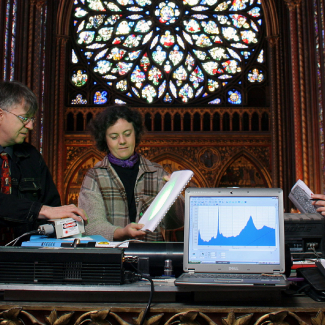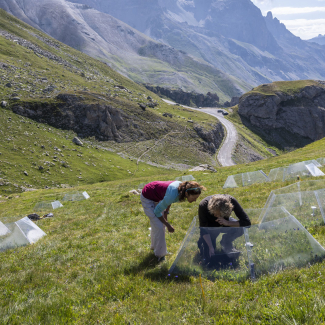
Europe and International
Thanks to its international foundation, the CNRS contributes to many major discoveries alongside its foreign partners. It takes part in planetary scientific and technological challenges, in connection with globalized research efforts that develop based on the free circulation of scientists and ideas.
A player in global science
A key player in international collaborative research
Audiodescription
Exchanging ideas for the dissemination of science
The CNRS is strongly committed to global scientific exchange. It collaborates with foreign laboratories, especially through its many publications that help promote French science by fostering research advances on the international level.
The mobility of borderless talent
The quality of posts and the great liberty in research that the CNRS guarantees are highly attractive to young scientists, from France and other countries alike. CNRS researchers are highly mobile, regularly travelling to attend international conferences, carrying out research in a partner laboratory or accessing a given research field. The 'fellow-ambassadors' programme also means internationally renowned scientists can come to CNRS laboratories to bolster their collaboration with French communities.
Steering international policy
The international policy of the CNRS favours a “bottom-up” approach, which is necessary in research dynamics. Cooperation originates in the field, and stems from the interest of researchers and their teams in the laboratories. The institution provides added value through its support for developing projects via tools that structure and strengthen collaborations.
An active presence in the field
The CNRS manages a network of 11 offices located at key global scientific hubs: Brussels, Melbourne, Nairobi, New Delhi, Ottawa, Beijing, Pretoria, Sao Paulo, Singapore, Tokyo, and Washington.
This international presence pursues multiple objectives:
- Promoting French scientific excellence
- Providing support for expatriate researchers or those on assignment
- Following up on cooperation agreements and facilitating relations with foreign partners, in connection with the scientific and cultural services of embassies.
Attractive cooperation tools
Partnerships adapted to the needs of researchers
Flexibility is key in adapting to changes in global science, as well as to meeting the needs of those conducting it. That is why the CNRS offers various international partnership tools: bilateral agreements, long-term scientific cooperation, the creation of international research networks around projects involving teams from different countries, etc.
Learn more about how the CNRS collaborates with enterprises
Research structures across the world
The CNRS is one of the world’s few research institutions to establish enduring joint research structures abroad. They can take different forms: international research laboratories (IRL); joint units with a French institute abroad (UMIFRE) in the humanities and social sciences, led in partnership with the Ministry for Europe and Foreign Affairs; and international research centres (IRC).
International Research Centres (IRC)
As umbrella structures, IRCs enable strategic dialogue between the CNRS and its prestigious partners, with a view to defining mutual interests and collaborations as part of joint and co-funded projects. Today the CNRS has 6 IRCs.
Our International Research Centers
In 2021, CNRS has designed a new way of cooperating with some of its main international partners, through its International Research Centres (IRC). These strategic partnerships are based on a clear ambition: to pool the resources and expertise of CNRS and its partner to consolidate existing collaborations between the two institutions, while paving the way for new inter- and trans-disciplinary projects identified jointly.
Audiodescription
International Research Laboratories (IRL)
Actual laboratories located within partner universities, IRLs bring together teams of researchers, students, postdoctoral fellows, engineers, and technicians from the CNRS and foreign partner institutions. Among the CNRS’s 80 IRLs worldwide, four were established in partnership with industry as part of innovation programmes, with a view to creating a working environment conducive to the emergence of future technologies.
The Cintra IRL in Singapore, with Thales
The E2P2L IRL in Shanghai, with Solvay
Research on green chemistry in partnership with a major global player in chemistry.
The Link IRL in Tsukuba, Japan, with Saint-Gobain
The Compass IRL in Pennsylvania, United States, with Solvay
The Europe of research
An ambitious institutional strategy
To maintain its involvement and increase its participation in research and innovation funding programmes, the CNRS has pursued an ambitious European action plan since 2021, which includes a number of components:
- the implementation of incentives and support for researchers seeking to submit European projects
- a communication and influence effort with Brussels institutions via the organisation’s Brussels office (in french).
The CNRS, a major actor in the European Research Area
European funding for research and innovation strengthens the competitiveness and attractiveness of the European Union throughout the world, stimulating cooperation between researchers from different member states, and ultimately fostering scientific advances that will be the innovation of the future.
A major player in the European Research Area (ERA), the CNRS is the leading beneficiary of these European funding programmes for research and innovation, notably the H2020 (2014-2020) and the current Horizon Europe programme (2021-2027).
Collaborative projects in response to major societal challenges
In connection with the Horizon 2020 programme, the CNRS is taking part in collaborative research projects focusing on six major societal challenges of the present and future: health; culture, creativity, and an inclusive society; civil security; digital technology, industry, and space; climate, energy, and mobility; food, bioeconomics, natural resources, agriculture, and environment.
Learn more about the Horizon Europe programme (in French)
Innovative Europe
In the face of intense international competition, the European Union must position itself as a key player in innovation on the global scale. This crucial commitment fosters prospects of economic growth for the continent, all while ensuring its technological sovereignty while facing the major challenges of the future. To achieve this objective, the Horizon Europe programme funds intensive research and development projects, and actively supports start-ups and enterprises in bringing their innovations to market. At the heart of this effort is the European Innovation Council (EIC), which identifies, develops, and accelerates revolutionary technologies and innovations. Since 2019, over 458 million euros of EIC funding have supported start-ups that emerged from CNRS laboratories.
For European science of excellence
European Research Council (ERC) grants
The European Research Council (ERC), which was created in 2007, funds ambitious exploratory research via individual research grants known as ERC grants, on the condition that the funded research be conducted within a European institution. The selectiveness of these grants is a recognition of the excellence of the research being conducted. The CNRS is the leading institutional beneficiary of ERC grants since their creation, with over 650 recipients (2007-2016) among its research units.
Marie Sklodowska-Curie Actions (AMSC)
Focusing on the international mobility of researchers and the showcasing of their careers in both the academic and non-academic world, Marie Sklodowska-Curie Actions (AMSC) are an essential lever for developing international collaborations, as well as those between public and private researchers.
Research infrastructure
Research infrastructure provides the resources and services used by numerous scientific communities in conducting their research. In France, the CNRS co-manages 80% of national infrastructure. Europe has a dense and varied network of such cutting-edge facilities, which benefits all researchers and allows them to conduct large-scale research.
Photo Credit: © Bruno JOURDAIN/LGGE/CNRS Images

